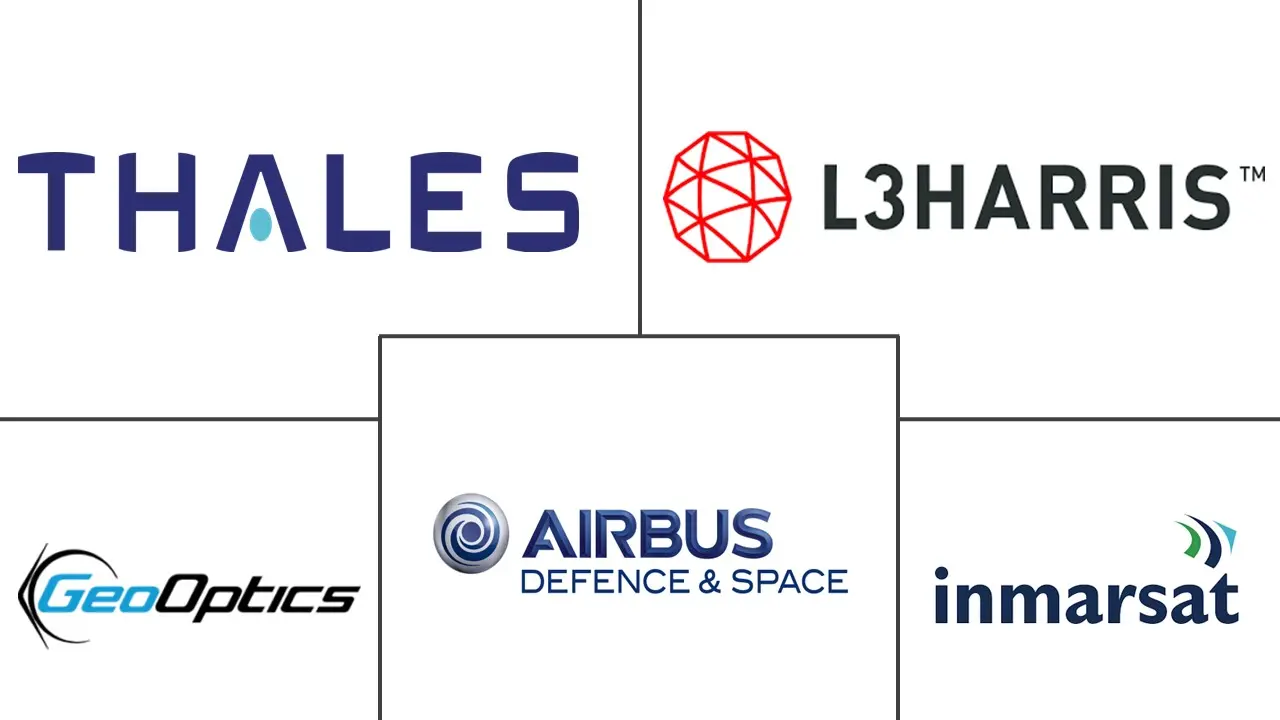Canada Satellite-based Earth Observation Market Size and Share
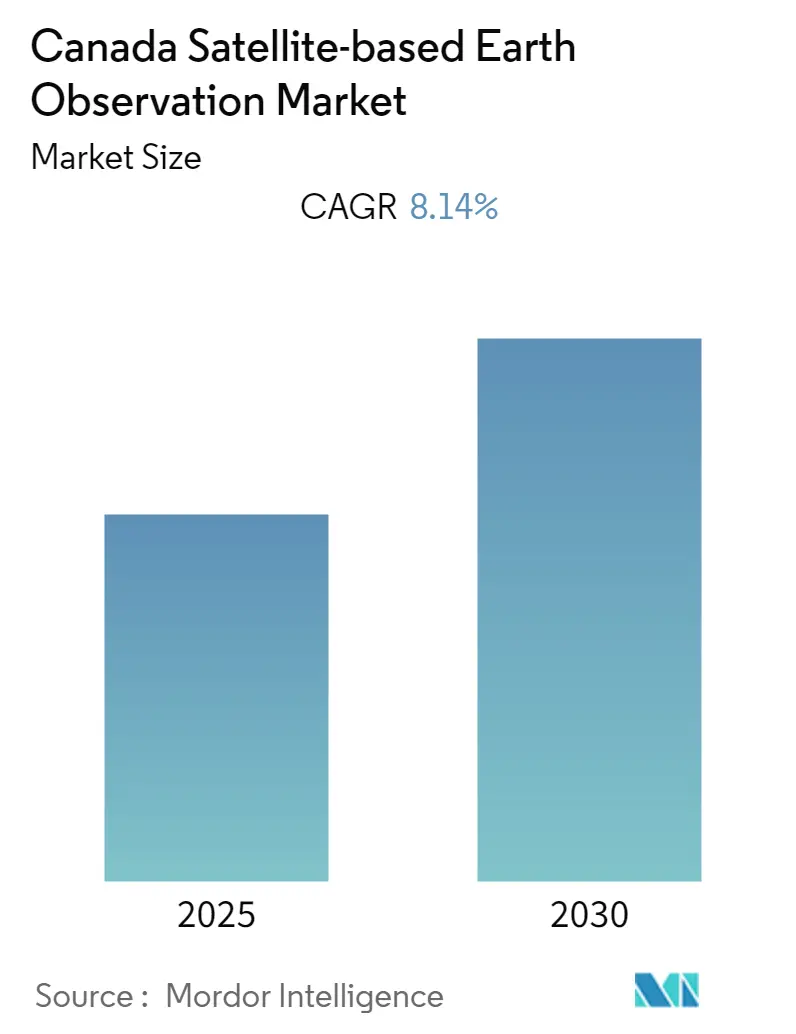
Canada Satellite-based Earth Observation Market Analysis by Mordor Intelligence
The Canada Satellite-based Earth Observation Market is expected to register a CAGR of 8.14% during the forecast period.
The Canadian Space Agency (CSA) has supported several satellite missions, including RADARSAT-1, RADARSAT-2, and RADARSAT Constellation Mission (RCM). These satellites provide valuable data for various applications, such as environmental monitoring, resource management, disaster management, and maritime surveillance.
- The rapid advancement in satellite technology has been a major catalyst for the growth of the Earth observation market in Canada. The development of high-resolution imaging sensors, hyperspectral sensors, and synthetic aperture radar (SAR) systems has significantly improved the capabilities of satellites in capturing detailed and accurate data. This technological progress has expanded the range of applications for satellite-based Earth observation, attracting various industries and government agencies to leverage these capabilities for their operations and decision-making processes.
- The increasing demand for geospatial data is another driving force behind Canada's satellite-based Earth observation market growth. Geospatial data provides valuable insights into the Earth's surface, enabling better planning, resource management, and informed decision-making. Industries such as agriculture, forestry, mining, energy, and infrastructure heavily rely on geospatial data for optimizing operations, assessing risks, and identifying potential opportunities. Additionally, government agencies require accurate geospatial data for policy formulation, land management, and environmental monitoring.
- Moreover, the Canadian government has recognized the importance of satellite-based Earth observation and has taken initiatives to promote its growth. Government agencies, such as the Canadian Space Agency (CSA) and Natural Resources Canada (NRCan), actively support research and development in satellite technology, data processing, and analysis. These agencies collaborate with industry players, academic institutions, and international organizations to foster innovation, knowledge exchange, and market development. Government support and partnerships have created a favorable environment for the growth of the satellite-based Earth observation market.
- Canada launched a satellite earth observation plan in 2022, including an investment of USD 8 million in 21 organizations throughout the country to pursue new applications focusing on Earth observation problems and sustainable development goals. The money will be provided through the Canadian Space Agency's (CSA) smartEarth program, which is intended to push Canadian organizations to solve challenges using satellite data and contribute to the resolution of actual problems on Earth.
Canada Satellite-based Earth Observation Market Trends and Insights
New Technologies Implementation in Earth Observation Satellite Technologies
- Canada has always been a frontrunner in implementing and advancing new earth observation satellite systems technologies. Among the key areas Canada has significantly contributed to are high-resolution imaging, SAR, hyperspectral imaging, CubeSats, AI/ML, and data analytics. These advancements have facilitated improved monitoring, analysis, and understanding of Earth's systems, benefiting industries, scientific research, and environmental management. With a strong foundation in satellite technology and a commitment to innovation
- One of the key advancements in earth observation satellite technology is the development of high-resolution imaging systems. Canada has been at the forefront of this technology, with companies like MDA (MacDonald, Dettwiler, and Associates) leading the way. These satellites employ sophisticated optical sensors and advanced image processing techniques to capture detailed images of the Earth's surface. High-resolution imaging enables accurate mapping, urban planning, disaster management, and resource exploration.
- Moreover, the government in the country is continuously increasing investments in its satellite. Hence, in March 2023, the Canadian government invested USD 6.8 million in developing new earth observation technologies in several areas. The Canadian Space Agency's Space Technology Development Program (STDP) has awarded 10 R&D contracts to 10 companies.
- Integrating artificial intelligence and machine learning algorithms in earth observation satellites is revolutionizing data analysis and interpretation. These technologies enable automated image processing, feature extraction, and pattern recognition, reducing the time and effort required for manual analysis. Canada has strong expertise in AI and ML, and researchers are applying these techniques to satellite data for enhanced land cover classification, vegetation monitoring, and disaster response.
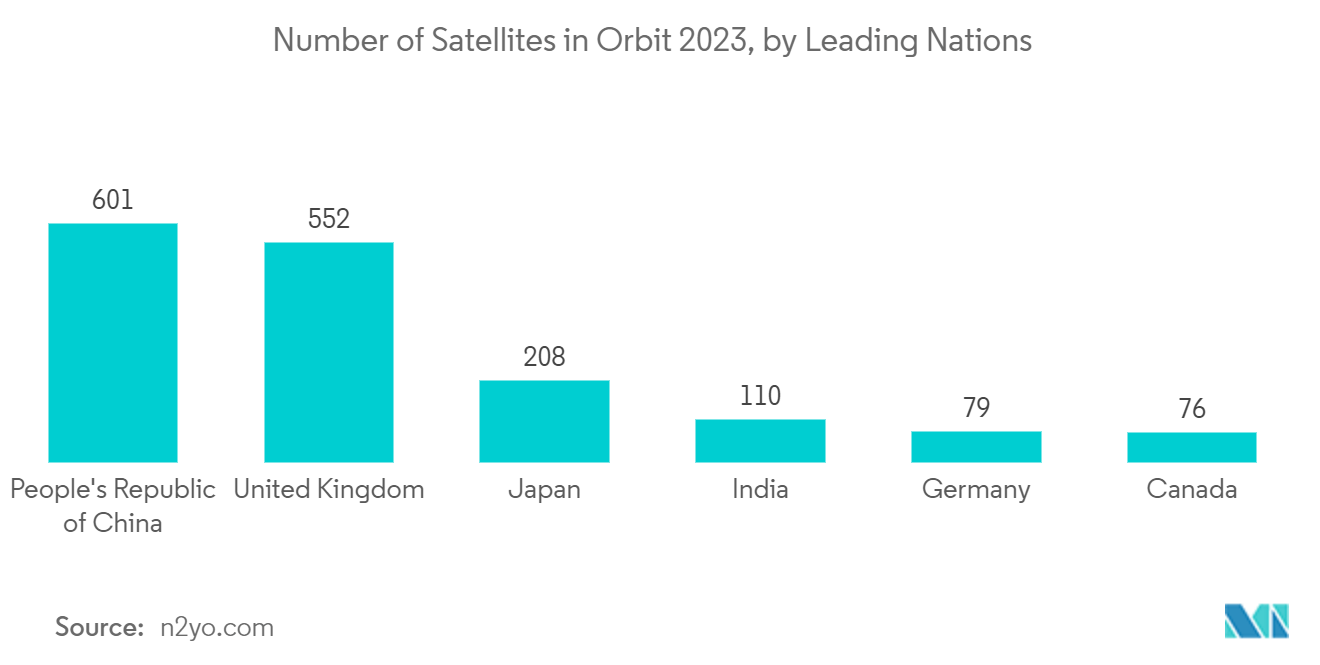
Increasing Use of Satellite based Earth Observation Technique in Agriculture
- Agriculture is a vital sector in Canada, contributing significantly to the country's economy and food security. In recent years, the implementation of earth observation satellites in agricultural practices has gained prominence due to their ability to provide valuable data and insights for improved farm management. This article explores the growing requirement for earth observation satellites in agriculture in Canada, highlighting the benefits, applications, and advancements in this field.
- Earth observation satellites play a crucial role in precision farming, enabling farmers to monitor and manage their crops with enhanced accuracy. Satellites with high-resolution imaging sensors capture detailed images of agricultural fields, allowing farmers to assess crop health, detect anomalies, and identify stress conditions. This information helps optimize resource allocation, such as water, fertilizers, and pesticides, leading to improved yields, reduced costs, and minimized environmental impact.
- Monitoring soil moisture is essential for efficient irrigation management, particularly in regions with varying climatic conditions. Earth observation satellites with specialized sensors can measure and map soil moisture levels across vast agricultural areas. This data assists farmers in determining optimal irrigation schedules, preventing overwatering or underwatering, and conserving water resources. Timely and accurate information on soil moisture also enables the identification of areas prone to drought or excessive saturation, facilitating proactive measures to mitigate potential crop losses.
- Advancements in earth observation satellite technology have significantly enhanced their applicability in agriculture. High-resolution imaging sensors, synthetic aperture radar (SAR), and hyperspectral imaging capabilities provide detailed and precise data on crop health, soil conditions, and environmental parameters. Furthermore, integrating artificial intelligence (AI) and machine learning (ML) algorithms with satellite data analysis enables automated crop monitoring, disease detection, and yield estimation. These advancements empower farmers with actionable insights and data-driven decision-making tools, contributing to improved productivity and sustainable agricultural practices.
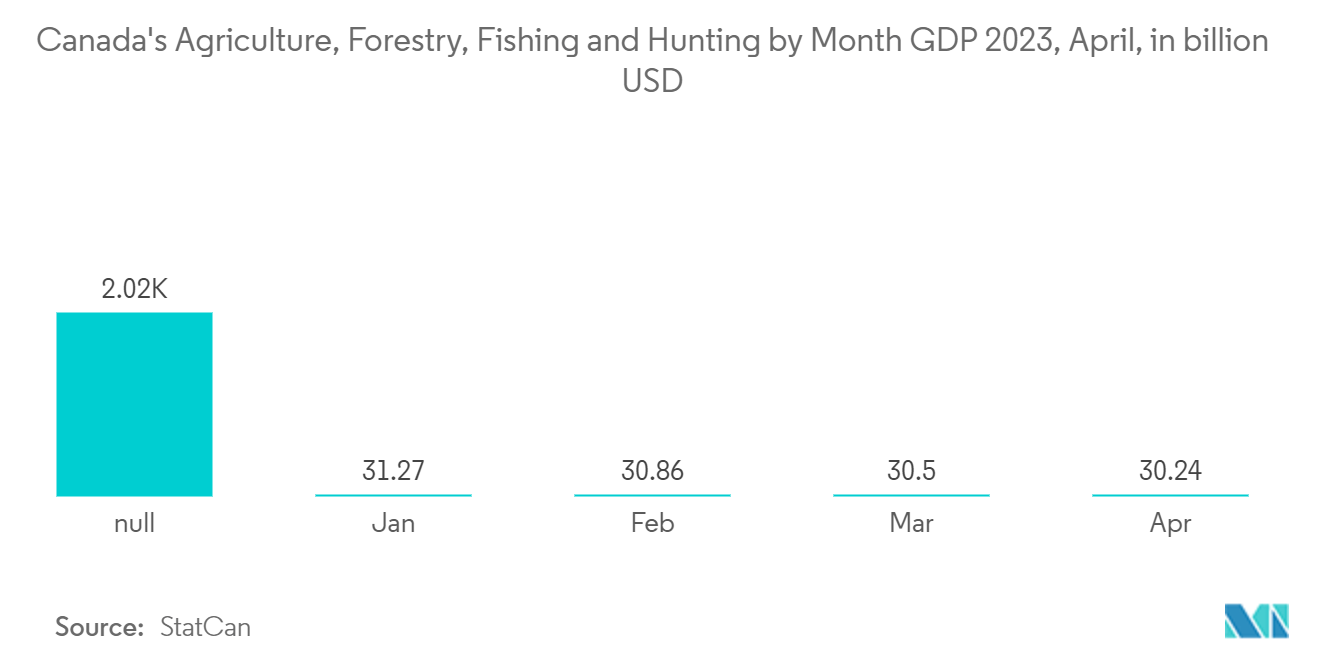
Competitive Landscape
Canada satellite-based earth observation market is consolidated, with the presence of major players like Airbus Defense and Space, Geo Optics Inc., MDA Corporation (Maxar Technologies), Planet Labs Inc., Inmarsat plc., L3Harris Technologies, Inc., Thales Group, TS2 Space, TerreStar Solutions Inc., and Telesat Canada. Players in the market are adopting strategies such as partnerships, innovations, mergers, and acquisitions to enhance their product offerings and gain sustainable competitive advantage.
In May 2023, the Canadian Space Agency (CSA) granted a contract to ExactEarth Ltd., a Spire Global, Inc. subsidiary, to do preparatory work for the implementation stages of a wildfire monitoring satellite. The contract calls for daily monitoring of all current wildfires in Canada from space to aid in wildfire management, to give Canadians more exact information on smoke and air quality conditions, and to estimate better the carbon emitted by wildfires.
In October 2022, Canada announced more funding for the NASA-led atmospheric monitoring system in the amount of USD 200 million to assist in launching a series of satellites that will help monitor and respond to climate change.
Canada Satellite-based Earth Observation Industry Leaders
-
Airbus Defense and Space
-
Geo Optics Inc.
-
MDA Corporation (Maxar Technologies)
-
Planet Labs Inc.
-
Inmarsat plc.
- *Disclaimer: Major Players sorted in no particular order
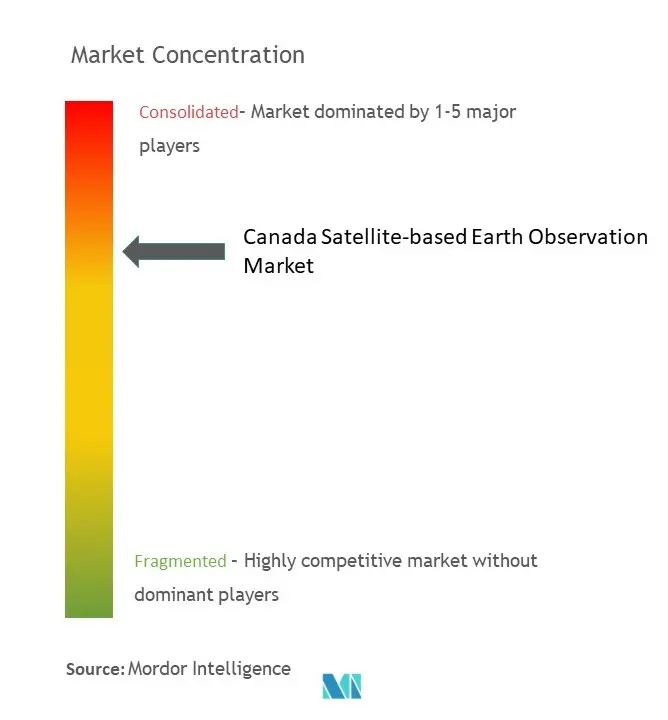
Recent Industry Developments
- May 2023: The University of Saskatchewan Canadian CubeSat Project used the spaceX CRS-28 rocket to launch the RADSAT-SK satellite. The satellite will collect radiation data for a year while in orbit.
- October 2022: The Canadian government announced that it would fund the development of a satellite and instruments for a NASA-led Earth science program. The Canadian government will fund the manufacturing of the satellite and other sensors for a NASA-led Earth research program.
Canada Satellite-based Earth Observation Market Report Scope
Canada satellite-based earth observation is done with the help of satellites orbiting around the planet to view and identify environmental changes, map making, etc. The satellite-based earth observation technology captures and stores information from satellites relating to the physical, biological, and chemical compositions of the Earth for monitoring, surveillance, and decision-making in various verticals, such as defense and intelligence, infrastructure and engineering, natural resource management, energy and power, and disaster management.
Canada's satellite-based earth observation market is segmented by type (earth observation data and value-added services), by satellite orbit (low earth orbit, medium earth orbit, and geostationary orbit), and by end-use(urban development and cultural heritage, agriculture, climate services, energy and raw materials, infrastructure, and other end-users).
The market sizes and forecasts are provided in terms of value (USD) for all the above segments.
| Earth Observation Data |
| Value Added Services |
| Low Earth Orbit |
| Medium Earth Orbit |
| Geostationary Orbit |
| Urban Development and Cultural Heritage |
| Agriculture |
| Climate Services |
| Energy and Raw Materials |
| Infrastructure |
| Other End-Users |
| By Type | Earth Observation Data |
| Value Added Services | |
| By Satellite Orbit | Low Earth Orbit |
| Medium Earth Orbit | |
| Geostationary Orbit | |
| By End-Users | Urban Development and Cultural Heritage |
| Agriculture | |
| Climate Services | |
| Energy and Raw Materials | |
| Infrastructure | |
| Other End-Users |
Key Questions Answered in the Report
What is the current Canada Satellite-based Earth Observation Market size?
The Canada Satellite-based Earth Observation Market is projected to register a CAGR of 8.14% during the forecast period (2025-2030)
Who are the key players in Canada Satellite-based Earth Observation Market?
Airbus Defense and Space, Geo Optics Inc., MDA Corporation (Maxar Technologies), Planet Labs Inc. and Inmarsat plc. are the major companies operating in the Canada Satellite-based Earth Observation Market.
What years does this Canada Satellite-based Earth Observation Market cover?
The report covers the Canada Satellite-based Earth Observation Market historical market size for years: 2019, 2020, 2021, 2022, 2023 and 2024. The report also forecasts the Canada Satellite-based Earth Observation Market size for years: 2025, 2026, 2027, 2028, 2029 and 2030.
Page last updated on:
Canada Satellite-based Earth Observation Market Report
Statistics for the 2025 Canada Satellite-based Earth Observation market share, size and revenue growth rate, created by Mordor Intelligence™ Industry Reports. Canada Satellite-based Earth Observation analysis includes a market forecast outlook for 2025 to 2030 and historical overview. Get a sample of this industry analysis as a free report PDF download.
